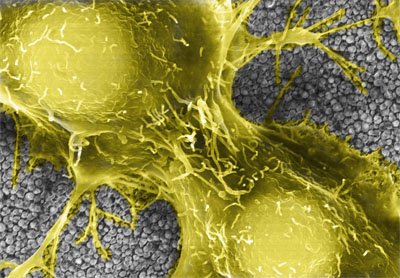 ME Professor Jianping Fu has two important research papers that were recently accepted for publication. Both papers were authored by Ph.D candidates at Fu’s lab, the Integrated Biosystems and Biomechanics Lab at the University, and they contain groundbreaking research on the use of synthetic micro/nanoscale materials to regulate human embryonic stem cell (hESC) functions.
ME Professor Jianping Fu has two important research papers that were recently accepted for publication. Both papers were authored by Ph.D candidates at Fu’s lab, the Integrated Biosystems and Biomechanics Lab at the University, and they contain groundbreaking research on the use of synthetic micro/nanoscale materials to regulate human embryonic stem cell (hESC) functions.
“Human embryonic stem cells (hESCs) hold great potential for future cell-based therapeutics,” Professor Fu said of their research. “However, their mechanosensitivity to biophysical signals from the cellular microenvironment is not well characterized by biologists. In our ACS Nano and PLoS ONE papers, we demonstrated for the first time that nanotopography and substrate stiffness as biophysical cues could provide potent regulatory signals over different hESC behaviors, including cell adhesion, proliferation, clonal expansion, and self-renewal. Our results provided important insights into the mechanosensitivity of hESCs to biophysical cues and further highlighted the important role of well-designed and controlled synthetic stem cell microenvironment to direct hESC behaviors desirable for functional tissue engineering and regenerative medicine.”
The first article, titled “Mechanics regulates fate decisions of human embryonic stem cells,” was published in PLoS ONE, an open-access journal for peer-reviewed material overseen by the Public Library of Science. This article’s first author is Yubing Sun, a graduate student research assistant at Fu’s lab. The research outline in this article investigated the mechanoresponsive behaviors of hESCs by fabricating microscale elastomeric pillar arrays on which hESCs were cultured and studied to judge their reactions to changes of substrate stiffness. This approach provided a novel way to characterize and understand mechanotransduction and its involvement in hESC function.
 “[Some] of the most important research in our lab is oriented toward developing synthetic micro/nanoscale ex vivo stem cell microenvironment to direct stem cell behaviors, and further employing them to identify the extrinsic physical factors and their downstream signaling pathways that regulate stem cell functions,” Fu said.
“[Some] of the most important research in our lab is oriented toward developing synthetic micro/nanoscale ex vivo stem cell microenvironment to direct stem cell behaviors, and further employing them to identify the extrinsic physical factors and their downstream signaling pathways that regulate stem cell functions,” Fu said.
The second article, titled “Nanotopography Influences Adhesion, Spreading and Self-Renewal of Human Embryonic Stem Cells,” was published in the American Chemical Society’s publication, ACS Nano, as well as being a featured item in ESC & iPSC News on April 11 (http://www.connexoncreative.com/publications/archives/ESC714.aspx) and C&EN News on April 24 (http://cen.acs.org/articles/90/web/2012/04/Texture-Surroundings-Influences-Human-Embryonic.html). Its first author is Weiqiang Chen, a graduate student instructor at the lab. This article and its research focused more on isolating the regulatory signals from surface nanotopography that influence hESC behavior.
Both of these publications are examples of the important research currently underway in Professor Fu’s lab, the Integrated Biosystems and Biomechanics Lab (IBBL). “Our lab is interested in developing unique micromechanical tools and systems for investigations of cell mechanics and mechanotransduction,” Fu said. “Indeed, I think we are one of the first few groups to study mechanobiology and mechanotransduction in human pluripotent stem cells, including hESCs.” For more information on his lab and the work being done there, visit them online at http://me.engin.umich.edu/ibbl/.
